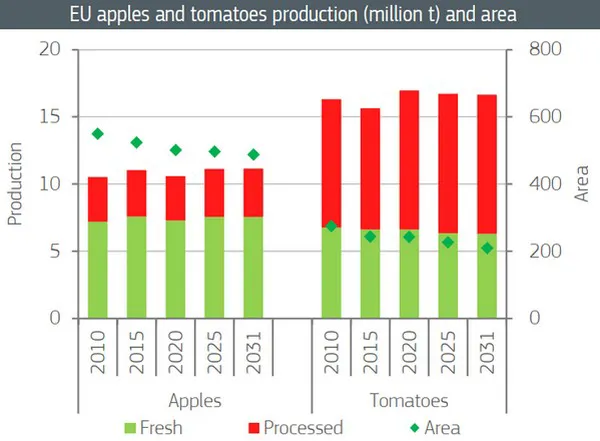By 2031, the production of fresh tomatoes is due to decrease (by -0.4% per year). The decline in tomato production is mainly driven by the strong drop of winter production in Spain and a shift to small-sized tomatoes which have a lower volume but higher added value. Spanish producers are also switching to other, more profitable crops in winter due to strong competition from Morocco. For peaches and nectarines, the continued decrease in the area under cultivation is pushing production down.
The total usable EU apple production is expected to remain stable by 2031, at 11.1 million t. This is the result of the decreasing area under cultivation and increasing yields resulting from the introduction of new, high-yielding dwarf varieties and improved agronomic management. It is projected that in 2031 7.6 million t of apples will be consumed fresh, while 3.6 million t could be used for processing.
Also, the production of tomatoes for processing is due to remain stable at around 10.4 million t. Production is shifting from highly concentrated products, such as tomato paste to less concentrated and higher value added products such as canned tomatoes, passata, tomato sauces and organic products.
EU fresh fruit consumption to increase while processed consumption decreases
By 2031, the EU consumption of fresh fruit and vegetables is expected to increase, driven by an increasing consumer awareness of the benefits of adopting a diet rich in fruit and vegetables, as well as public initiatives to promote their consumption. However, there are significant differences across sectors and between EU countries. In particular, the EU consumption of fresh oranges is due to increase to 13.3 kg per capita (+0.5% per year). The consumption of freshly squeezed orange juices in supermarkets, cafes and restaurants will boost their consumption.
Over the same period, the EU per capita consumption of fresh apples is expected to increase to 15 kg (+0.6% per year), driven by changing apples varieties to varieties which better reflect consumers’ preferences, in particular in Poland. Despite the projected increase, the apple is losing competitiveness from more trendy products such as tropical fruits and berries.
Click here to read the EU agricultural outlook report.
For more information: ec.europa.eu

